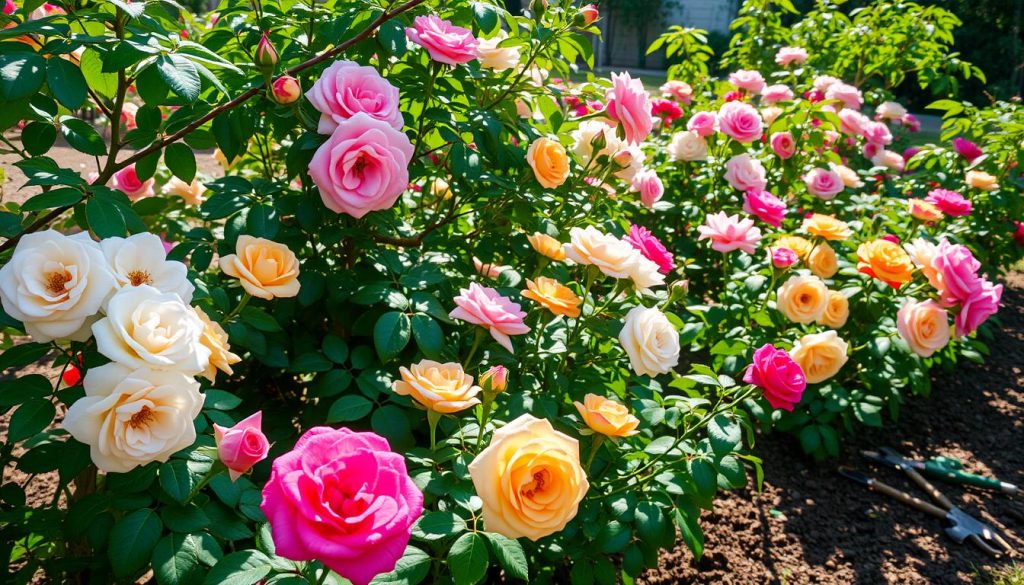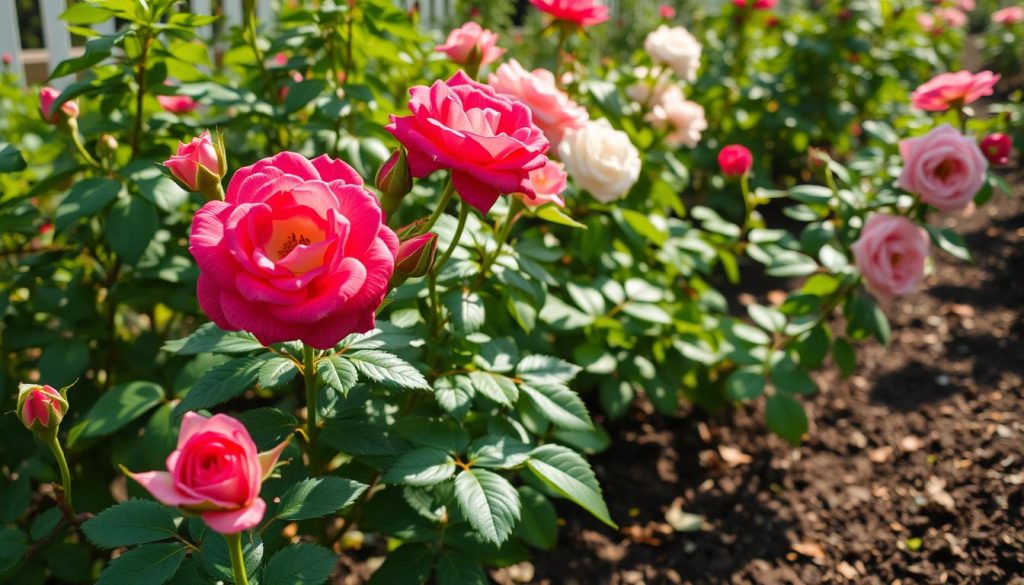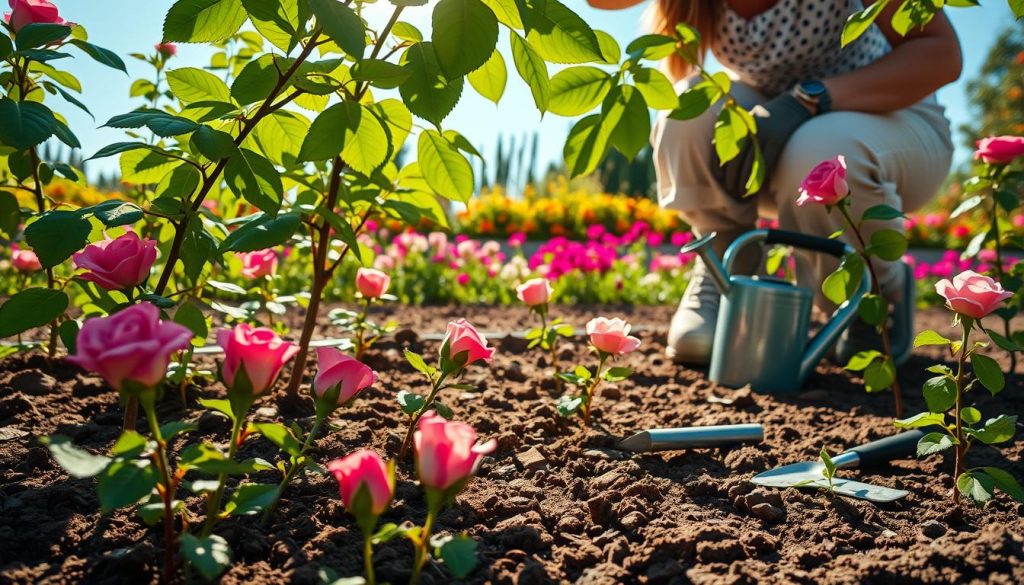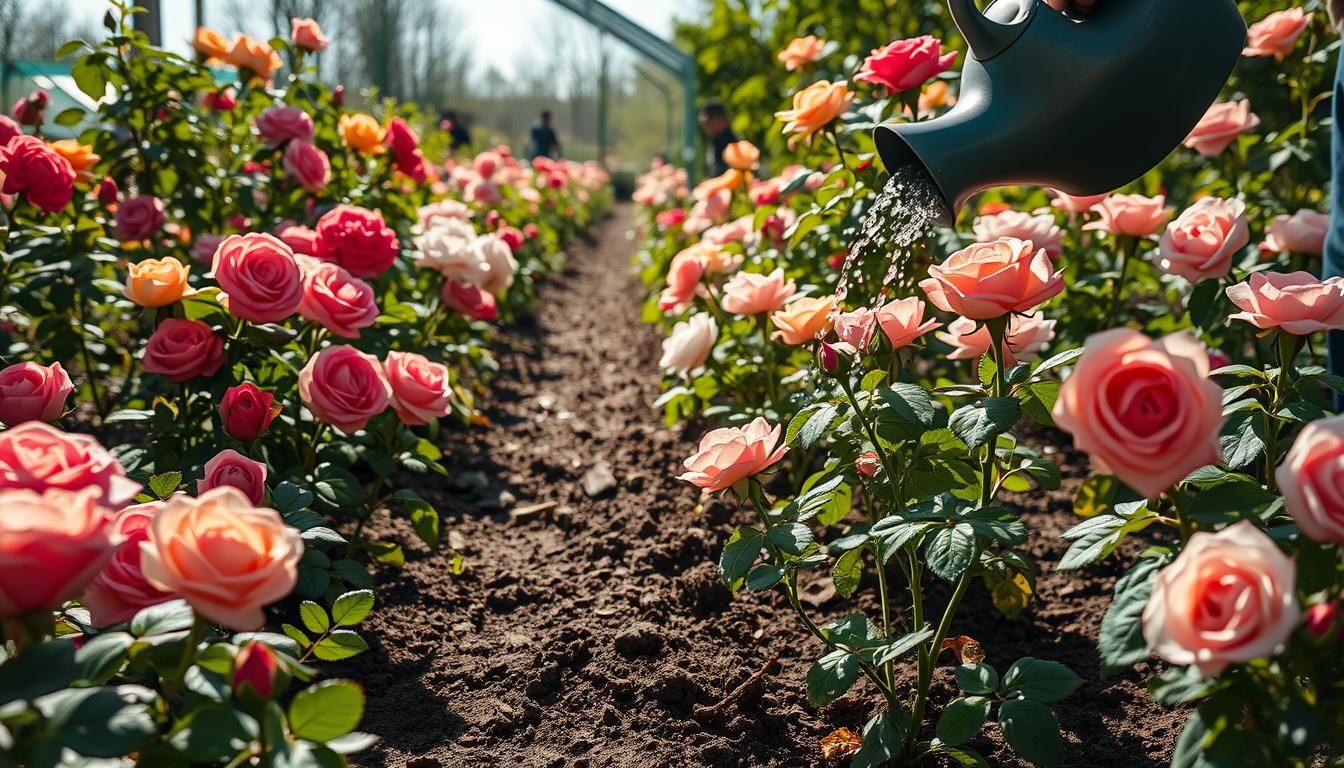I’m excited to share my experience growing roses. I’ve found that with the right care, anyone can grow beautiful roses. Growing roses is fun and rewarding, and I’m here to help you start.
First, you need to know the basics of rose care. This includes planting and harvesting roses. Follow these simple steps to enjoy beautiful blooms in your garden. I’ll share all you need to know about rose care and gardening.
In this article, I’ll share my personal tips on growing roses. You’ll learn the knowledge and skills to create a stunning rose garden. Whether you’re new or experienced, my goal is to help you grow beautiful roses.
Choosing the Right Rose Varieties for Your Garden
Choosing the right rose variety is key to growing healthy roses. With many options, picking the right one can be tough. Here are some tips to help you decide.
For a successful rose garden, pick varieties that do well in your area’s climate and soil. This way, you’ll have roses that need little care and maintenance.
Popular Rose Types
- Hybrid teas: Known for their large, repeat-blooming flowers
- Floribundas: Produce clusters of blooms and are often used in landscaping
- Climbers: Train these roses to grow up walls, trellises, or other supports

Disease-Resistant Options
Some roses are better at fighting off diseases like black spot and powdery mildew. Look for varieties bred to resist these diseases. Also, follow good rose care tips to keep diseases away.
Fragrant Varieties
If you want roses with a strong scent, think about hybrid teas or floribundas. These roses have a sweet smell. They’re great for cutting gardens or making perfumes.
Preparing Your Soil for Planting Roses
To make sure your roses grow well, you need to prepare the soil first. A good soil mix is key for healthy growth. Fertilizing roses is also important for their health and blooms.
I test my soil pH before planting to see its acidity level. This tells me if I need to add organic matter to make the soil better for roses. Stuff like compost or manure can really help the soil, making it better for your roses.
Testing Soil pH
Testing soil pH is easy with a soil testing kit. The kit shows a color chart to tell you the pH level. If it’s not right, you can add lime or sulfur to fix it.
Adding Organic Matter
Adding organic matter is a great way to make the soil better. I mix in a 2-inch layer of compost or manure. This makes the soil rich and balanced, perfect for my roses.

Improving Drainage
Good drainage is key to stop waterlogged soil. I add perlite or vermiculite to help. This keeps the roots healthy and ensures my roses get the right water and nutrients.
By doing these steps, I create a soil mix that’s just right for my roses. With good soil, pruning, and fertilizing, my rose garden will be beautiful and healthy.
Planting Roses: Timing and Techniques
Timing is key when planting roses. In the U.S., the best planting seasons vary by location and climate. Spring and fall are usually the best times, with mild weather and plenty of soil moisture. These seasons are also ideal for fertilizing roses, as they need nutrients to grow well.
To plant roses successfully, start by preparing the soil. Test the soil pH, add organic matter, and improve drainage. When the soil is ready, dig a hole for bare-root roses that’s twice as wide and as deep as the root ball. Mix in organic matter, then gently place the rose in the hole. Watering is crucial at this stage to help the roots settle.

Best Planting Time in the U.S.
In northern states, plant roses in spring after the last frost. For southern states, fall is better, with cooler weather and less disease risk. Planting at the right time helps prevent diseases and ensures a healthy start for your roses.
How to Plant Bare-Root Roses
- Dig a hole that is twice as wide and just as deep as the root ball
- Add organic matter to the soil
- Gently place the rose in the hole
- Water thoroughly
By following these steps, you can create a thriving rose garden. Remember to water, fertilize, and prevent diseases. With proper care, your roses will bloom beautifully, adding joy to your garden.
Watering My Roses Effectively
Watering is key to keeping roses healthy. It’s important to know how much water they need. This helps prevent diseases and makes blooms better. Here are some tips for rose care:
Understanding Moisture Needs
Roses need about 1-2 inches of water each week. This can come from rain or a hose. To check if the soil is dry, stick your finger in it up to your knuckle. If it’s dry, it’s time to water.
Best Practices for Watering
Here are some tips for watering your roses:
- Water deeply to encourage deep root growth
- Water in the morning to allow the plants to dry out before nightfall
- Avoid getting water on the leaves to prevent fungal diseases

Tips for Mulching
Mulching keeps the soil moist, stops weeds, and keeps the temperature right. I use a 2-3 inch layer of organic mulch around my roses. It should be a few inches from the plant base. By following these tips and watering right, I can keep my roses healthy and blooming. This makes my garden beautiful and thriving.
| Rose Care Tip | Benefits |
|---|---|
| Watering deeply | Encourages deep root growth, makes plants more drought-tolerant |
| Mulching | Retains moisture, suppresses weeds, regulates soil temperature |
| Watering in the morning | Allows plants to dry out before nightfall, reduces risk of fungal diseases |
Fertilizing Your Roses for Optimal Growth
To make sure my roses grow well, I follow important care tips. Fertilizing is key for healthy roses. It’s important to do it right. By using the best gardening practices, I create a good fertilizer plan.
Choosing the right fertilizer and when to use it is important. There are many fertilizers out there. Knowing the basics helps me make the best choice. I think about the rose type, soil, and climate.
- Choose a fertilizer that is specifically formulated for roses
- Follow the instructions on the fertilizer package for application rates and timing
- Consider the pH level of your soil and adjust the fertilizer accordingly
By following these tips, my roses can thrive and bloom beautifully. Growing healthy roses needs care and attention. But with the right steps, it’s very rewarding.
Pruning Roses for Health and Shape
Pruning is key to growing healthy roses. It keeps their shape and encourages growth. To prune well, know when to do it, the tools needed, and the right techniques. Pruning at the right time helps your roses focus on new growth and blooms.
Before fertilizing roses, prune them first. This ensures the fertilizer goes to the right spots. I use sharp pruning shears and loppers for clean cuts. It’s also important to remove dead or damaged branches to stop disease.
- Prune your roses in late winter or early spring, before new growth begins
- Remove any dead or damaged branches to prevent disease
- Use sharp pruning shears and loppers to make clean cuts
- Prune your roses to maintain their shape and promote healthy growth
By following these tips and using the right pruning techniques, your roses will thrive. Regular fertilizing also helps with growth and blooming.
| Rose Type | Pruning Tips |
|---|---|
| Hybrid Teas | Prune in late winter, removing any dead or damaged branches |
| Floribundas | Prune in early spring, cutting back stems to about 12 inches |
| Shrub Roses | Prune in late winter, removing any dead or damaged branches and shaping the plant |
Protecting My Roses from Pests
To keep my roses healthy, it’s key to protect them from pests. This means preventing diseases by keeping the garden clean and watering right. Also, checking my roses often for pests or diseases helps catch problems early.
Common Rose Pests and How to Identify Them
Aphids, whiteflies, and spider mites are common pests of roses. Spotting these pests early is important for treating them. Regular fertilizing and proper watering help prevent disease and pests.
Natural Remedies for Pest Control
Using natural remedies like beneficial insects or neem oil can control pests. Combining these with good gardening habits keeps my garden healthy. This way, I prevent diseases and encourage my roses to grow well.
Managing Diseases in Rose Plants
As a rose lover, I know how vital it is to keep my plants healthy. I make sure to water them right and follow key care tips. This helps prevent many common diseases.
Boosting rose blooms is crucial. I give them enough sunlight, fertilize them often, and prune them well. These steps help my roses grow strong and healthy.
Common Rose Diseases
- Black spot: a fungal disease that causes black spots on leaves
- Powdery mildew: a fungal disease that causes a white, powdery coating on leaves
- Rust: a fungal disease that causes orange or yellow spots on leaves
Preventative Measures
To stop these diseases, I mix organic and chemical methods. I use fungicides and insecticides. I also water my roses carefully, using soaker hoses or watering cans to reach the roots.
Creating the Ideal Rose Garden Environment
To make your rose garden thrive, think about the environment. You need the right sunlight, use companion planting, and create windbreaks. These tips will help you grow a beautiful and healthy garden.
Roses need at least 6 hours of direct sunlight a day. This is key for their growth and blooming. Also, companion planting helps keep pests away and improves the soil.
Some great plants to grow with roses are lavender, marigolds, and garlic. They help create a balanced garden and support your roses’ growth. Adding these plants makes your garden a thriving space.
Creating windbreaks also protects your roses from harsh weather. Plant trees or shrubs around your garden. By following these tips, you’ll create the perfect environment for your roses.
| Companion Plant | Benefits |
|---|---|
| Lavender | Deters pests, promotes relaxation |
| Marigolds | Repels nematodes, attracts beneficial insects |
| Garlic | Repels aphids, improves soil health |
Seasonal Care for Thriving Roses
To keep my roses healthy, I follow a seasonal care routine. This includes pruning, fertilizing, and protecting them from pests and diseases. Growing healthy roses requires attention to their needs all year round. With the right care, they bloom beautifully and fragrantly.
Spring Preparation
In the spring, I prune my roses to remove dead or damaged branches. This encourages new growth. I also fertilize them with a balanced fertilizer to give them the nutrients they need.
Summer Maintenance
In the summer, I water my roses regularly and provide support to prevent them from toppling over. I also watch for pests and diseases, acting quickly if I see any.
Fall Preparation for Winter
In the fall, I prepare my roses for winter. I stop fertilizing and pruning, focusing on protecting them from cold temperatures and frost. I use mulch to insulate the soil and prevent it from freezing. I also bring potted roses indoors to protect them from harsh weather.
By following these seasonal care tips, I keep my roses healthy all year. Whether in a garden or containers, fertilizing and pruning regularly is key. This makes a big difference in their health and beauty.
With the right care, roses can be a beautiful and fragrant addition to any space. By following these tips and using proper rose care techniques, you can enjoy your roses for years.
Harvesting and Enjoying My Roses
Harvesting and enjoying my roses is the best part of growing them. To cut roses right, I pick mature buds and use clean, sharp pruners. I make a diagonal cut just above an outward-facing leaf node. This helps them grow more and bloom again.
Creating bouquets with fresh-cut roses is a joy. I try different vase shapes and mix colors. I also add greenery to make the bouquets look amazing. Keeping the water fresh and re-cutting stems helps my roses last longer.
Enjoying my roses’ fragrance and beauty is the greatest reward. I put them all over my home. Their scent fills the air and adds elegance. Whether I’m admiring them alone or sharing them, my roses bring me joy and inspiration.

